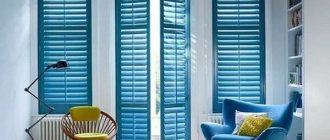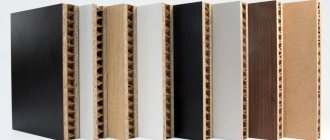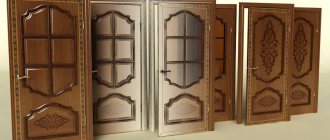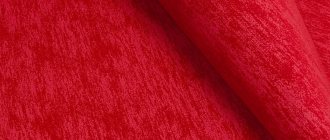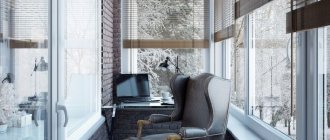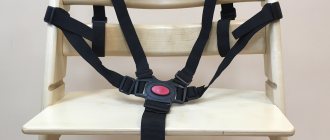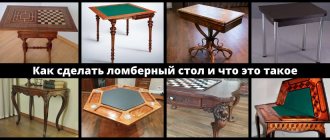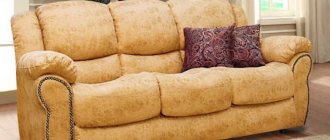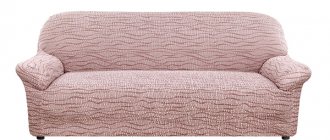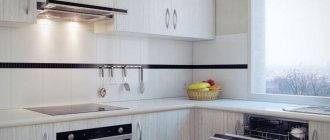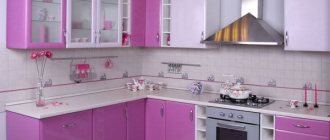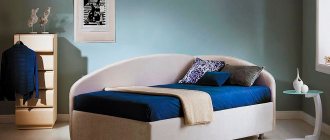The need to restore or repaint the decorative coating on plastic parts and PVC cladding arises much more often than it might seem at first glance. This could be the surface of metal-plastic veranda windows, the housing of home appliances, a soft inflatable boat, plastic body parts on a car, and even protective fabric covers. Painting PVC plastic is not particularly difficult, but on one condition, if you have special paint for PVC.
How and with what to paint a kitchen set with your own hands: photos, videos, procedure
Any interior needs updating over time. Painting kitchen facades is the easiest and most cost-effective way to change a boring design or save on buying a new kitchen set. Modern manufacturers offer consumables for every taste and budget, so making a choice is not so difficult. Moreover, even a non-professional can update facades, so there is no point in turning to a specialist for help. How to paint a kitchen set with your own hands, and what paint is better to use? Specialists and experienced designers will answer these and other questions.
Types of coatings
Kitchen fronts are the front parts of cabinets with doors and drawers. They can be solid or prefabricated, with swinging, sliding, lifting structures or accordion-folding ones. When choosing a kitchen set, first of all, pay attention to the physical characteristics of the material: moisture resistance, fire resistance, strength, etc. However, over time, any product loses its former attractiveness due to long-term use, sunburn, and mechanical damage. Then the question arises, is it possible to update the kitchen façade with your own hands? Before you start work, you should understand the features of the material from which the facade is made.
- Kitchen furniture made of wood attracts with its environmental friendliness and luxury, and also fits perfectly into classic and modern interiors. In order to preserve the original appearance of the product, special care and periodic restoration are required so that pests do not destroy the wood, and the doors do not become deformed due to moisture.
- Laminated chipboard is an inexpensive option, but completely impractical. Chipboard has a loose structure, which causes the material to swell in a humid environment.
- MDF facades are the most popular and versatile due to the durability of the material and a wide selection of colors. MDF facade panels can be either simple, flat, or rounded and asymmetrical.
- Plastic has the longest service life. It is applied to an MDF panel, sometimes chipboard. Such facades are not afraid of moisture, steam, temperature changes and aggressive household chemicals. Painting them is the most difficult, since it is difficult to select the necessary consumables.
- A set with glass inserts looks rich and luxurious, and never goes out of style. Glass is usually inserted into an aluminum profile or MDF panel, although there are also frameless structures, where the entire load falls exclusively on high-quality and durable fittings. To update the facade, you can use stained glass paint, with which you can create a unique pattern or design.
Additional protection
Acrylic dyes have good adhesion to PVC. But you can increase the service life of the coating by additionally protecting it with a glossy water-based plastic varnish. In addition, the product acquires shine and a beautiful appearance.
This additional protection is relevant for window sills and windows in the kitchen. The impact of aggressive factors is reduced.
The protective layer is applied with a brush. There are no difficulties in the work, so you can apply the varnish yourself.
If the window sill or plastic pipe is located close to the fire source, then they are covered with fire-retardant CM. These are compositions intended for coloring metal.
Materials and tools
In the process of updating and painting old kitchen furniture, you should first prepare everything you need:
- a screwdriver and hammer drill will be useful during the dismantling of facades, fittings, as well as their subsequent assembly;
- coarse and fine-grained sandpaper or a grinding machine will become an indispensable tool at the initial stage of grinding the surface of the product;
- the solvent is necessary to degrease the surface;
- the primer will help make the surface smoother so that painting occurs successfully and is evenly distributed over the surface of the product;
- A paint brush with soft and hard bristles is needed in the process of painting the product. Sometimes it can be replaced with a roller with an additional paint container.
- gloves, goggles and a respirator are necessary for personal protection from harmful substances entering the body when painting and consumables on the body.
In some cases, you may need masking tape to stick to areas that do not need painting. To paint a kitchen with chipboard facades, you will need to first get rid of the film. In this case, a hair dryer will come in handy.
Do-it-yourself painting of kitchen facades is carried out using the following materials.
- Acrylic paint. Today, the range of this material is impressive: a wide color palette, different textures. The substance does not have a pungent odor, so you can repaint the kitchen even in a living room. You can choose acrylic in aerosols or in liquid form - this does not affect the quality of painting in any way. However, acrylic has significant disadvantages: it is not moisture resistant and can hardly withstand temperature changes. In a place where a lot of cooking is done, a kitchen set with such a coating will not last long and will quickly become unusable.
- Auto enamel. This option is recommended by experienced specialists for kitchen furniture. The substance is not afraid of steam, moisture, high temperature, and direct sunlight. Auto enamel perfectly strengthens the base, painting makes it more impact-resistant. This product is resistant to mechanical damage, so it is not so easy to accidentally scratch it. In addition, manufacturers offer a wide range of different colors and shades, which can also be mixed and experimented with the appearance of kitchen facades.
Painting facades
Before painting the facades, you should dismantle them, remove the handles, fittings, and cover the decorative inserts and hinges with masking tape so that nothing gets in there during painting. After this, you need to lay newspapers or film on the work surface so as not to stain the floor or kitchen table with paint. Before painting, you should also wear protective equipment: gloves, goggles and a respirator. Even if the paint is non-toxic, dust cannot be avoided during the sanding process.
Grinding
Before painting the kitchen unit, you should remove the old coating. In this case, it is necessary to treat the surface with sandpaper, first coarse-grained, and then fine. A grinding machine will greatly facilitate manual labor. You can also use nail polish remover. To remove PVC film you will need a hair dryer. With its help, you need to heat the film from the front side and carefully remove it from the facade. Please note that during the work a rather pungent odor will be released, so it is advisable to choose a non-residential premises for this procedure. After sanding, you need to remove dust from the surface with a damp sponge or rag, and then degrease it with a special solvent.
Primer
Primer for plastic or wood differs in composition, so before updating the kitchen facade, consult with a sales consultant in choosing the right product. The quality of the primer determines how well the painting will proceed. The substance must be applied in 2 thin layers. After each application, it is recommended to wait until it dries completely and then leave the product for a day.
Coloring
To properly paint kitchen facades with your own hands, you need to cover the surface with enamel in 2-3 layers using a brush with soft bristles or a roller, strictly adhering to one direction. In this case, a spray can will be very effective, as it is easy to distribute the paint evenly. When using multiple colors or shades, the borders can be protected from paint using tape. After painting, you must also wait until it dries completely. The estimated time is usually indicated on the can or spray paint can.
Finish coating
A substance called glisal is often applied to the surface of the product after painting to give it a glossy shine. The product must be diluted with water in the proportion specified in the instructions and applied to the facade. The glaze method will help create decorative patterns. Using polyethylene, a damp sponge and a hard-bristled brush, you need to move from one area to another, drawing chaotic lines and patterns. After work, you should leave the product to dry for a week. There is also an option to open the kitchen facades with regular varnish. It can be glossy or matte, but it is advisable to choose a transparent substance. Both glisal and varnish have a pungent odor, so it is necessary to ventilate the kitchen after work. When the product is dry, all that remains is to assemble it and attach the updated facades back to the set.
What could be nicer than giving new life to an old but beloved product? Anyone can feel like a designer and restorer; all it takes is desire and creative inspiration. You can paint the kitchen set with your own hands by watching the instructional video, as well as photo instructions presented on the website.
We repaint laminated furniture with our own hands - stages of work
Stage 1 - Preparatory
The laminated surface of any furniture is plastic (polyvinyl chloride, PVC), resistant to water. If you paint such a smooth surface, the paint will not stick, even the most expensive and high-quality one. Therefore, the surface must be carefully prepared. First, you should remove all fat from the surface using special solvents and detergents.
To make work more convenient, it is better to disassemble the furniture. But if you only need to repaint the facades, then you can remove only them from their hinges and lay them on a horizontal surface. If the fittings are not removed during painting, then it makes sense to protect them with masking tape.
Stage 2 - Sanding the surface
To prevent the paint from falling off after application, the top layer must be removed from the laminated surface. Sandpaper is suitable for this. First, you should use a coarser-grain sandpaper to remove the laminating layer, and then sand the furniture with a fine-grain sandpaper. This treatment will create a rough surface on which the paint will adhere better.
Do not forget to use personal respiratory protection when working, as dust from plastic is quite harmful.
Stage 3 - Sealing cracks
To seal cracks and chips, you need to use either a special composition based on epoxy resin or putty (preferably latex). Before treating cracks, they must be primed and allowed to dry. Then the cracks are sealed and the composition is also allowed to dry completely. A small spatula is used as a tool.
Stage 4 - Surface priming
Priming is a mandatory step before painting. A good quality primer will prevent the paint from peeling and bubbling. Give preference to a polyurethane-based primer; this composition sticks to everything, even glass and ceramic tiles.
If such a composition is not available, then you can purchase a primer in cans intended for painting a car. But when working in it, the presence of a respirator becomes a prerequisite. The soil must dry for at least 12 hours.
If you plan to paint the furniture in a specific color, then the primer can also be tinted in the selected shade to create some kind of “background”.
Stage 5 - Painting
Which paint to choose for laminated furniture? This is the first question that craftsmen ask before painting. Of course, it is better to give preference to special paints marked “for furniture,” but alkyd or polyurethane paints are also an excellent solution. But epoxy-based paints, although they give excellent results, take a long time to dry and stink. You can use such paints only if painting takes place somewhere in a garage or shed.
Chalk paint would be an excellent solution, especially since you can make it yourself.
To paint furniture made of laminated chipboard, you can also choose acrylic paints, but in this case you will have to prime it at least twice beforehand.
As a tool, choose a short-pile velor roller - such rollers paint much better than foam rollers and create an even layer. For hard-to-reach places, such as corners, choose brushes of different sizes (you’ll have to check which one is convenient for you - you’ll have to check it in practice).
So, you will have to paint in two layers, allowing the first layer to dry thoroughly. If suddenly for some reason something cannot be painted over, then this place can be decorated, for example, using the decoupage technique.
Stage 6 - Protection
If repainted furniture is exposed to active moisture or wear (for example, kitchen facades or furniture in the hallway), then applying varnish over the paint would be an appropriate solution. Choose acrylic varnish; both glossy and matte varnishes are available. The varnish is applied either with a brush or a roller to completely dry paint.
Consolidate the result
Acrylic paints after processing PVC products are able to stay on the surface for quite a long time. But you need to use a gloss varnish to provide additional protection. Such materials are created on a water basis and play the role of a decorative coating, making the product shiny. After painting, PVC plastic looks attractive.
Such compositions are excellent for processing almost any PVC product that has already been painted previously. Especially in rooms where the surface is constantly negatively affected. Applying varnish does not require additional skills; it is enough to use a regular brush or aerosol.
Review and application of paints on plastic (2 videos)
Different paints for PVC (24 photos)
MDF facades: PVC or paint?
Kitchen with MDF film facades MDF facades are very popular. Kitchen furniture with such fronts is preferable to solid wood furniture. Firstly, because solid wood is more expensive. Secondly, such material is less practical.
Despite the fact that MDF is essentially sawdust. MDF facades have the following advantages:
- strength
- durability
- resistance to external negative influences
Environmental friendliness is another advantage. No harmful substances are used when pressing sawdust. They stick tightly to each other due to the release of a special substance contained in the wood. The problem of choice does not end there.
Which ones should you choose?
Each of the facade options proposed above has its own disadvantages and advantages. In general, thanks to modern production technologies, they all work perfectly in the kitchen, but there are nuances. For example, painted facades, unlike film ones, cannot have a wood structure or pattern, but we have the opportunity to give them absolutely any color. The disadvantage of plastic facades is that milling cannot be done on such facades. At the same time, there is a definite plus: they can withstand temperatures up to 240 degrees Celsius (according to some experiments, even more).
Solid wood facades are a very individual product that is not suitable for everyone. Firstly, they are quite expensive compared to all other options. Secondly, they require proper conscious care. But with good care they will last in the kitchen for up to 50 years, and possibly longer.
Is it possible to paint laminated chipboards in a different color?
Laminated particle board is a chipboard lined with melamine or thermosetting polymer film. Additionally, the surface of the plate is varnished. The resulting coating gives the material the following properties:
- smoothness;
- moisture resistance;
- scratch resistance;
- improved appearance.
The smooth and moisture-resistant surface of laminated chipboard has low adhesion, so when painting the slab, the paint collects in drops. This does not happen when working with conventional chipboard because it has good wettability. This allows the paint to penetrate deep into the structure of the material and cover it with an even layer.
If you can't change the color of the board just because of the non-wettable surface, the question arises: is it possible to paint laminated chipboard after removing the cladding? Yes, matting a varnish coating is a popular way to improve its adhesion. In this case, there is no need to strip it down to the melamine or polymer film, much less remove the film itself. It is enough to go through sandpaper twice. The first time - with a coarser sandpaper (P60), the second - with a softer one (P150).
Production of MDF with paint and MDF with film
The film is applied to MDF facades using a press, creating high temperature and vacuum. Paint is applied under normal conditions: at “room” temperature, with existing atmospheric pressure. First, the surface of the MDF facade is coated with a primer. Next, a special enamel is applied. If necessary, additional layers of enamel are applied and the façade is varnished.
The properties of furniture facades also depend on coating technologies.
Surface cleaning
The first thing we will start with is removing the film from the facades. So let's get started.
We have removed all the film, now we need to prepare the surface for applying insulator primer. There is glue left on the facades that has saturated the MDF and we must seal it so that over time it does not show up as yellow spots on the painted surface.
Since the film was glued to the facades, the MDF itself was saturated with glue and it was no longer possible to remove it. Therefore, with the help of an insulator, we will seal all the absorbed glue under a layer of special primer; it forms a film and will not allow glue stains to appear in the future.
